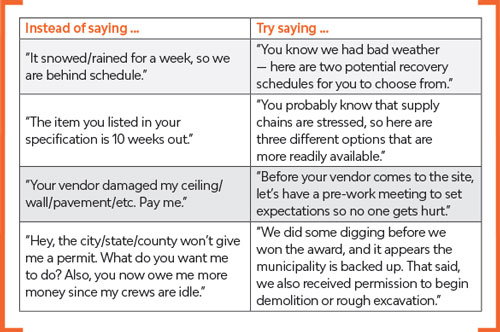
No one wakes up and thinks, “How can I make an unmitigated disaster of this project? And, most importantly, annoy my best customer?” Yet, construction leaders regularly make errors that serve to irritate their customers.
Certainly, customers can be frequently fallible as well. They do things that can adversely impact the contractor, such as using unrealistic budgets, creating impossible timelines and overstaffing a project with tradespeople.
In an era in which everyone can Google an immediate answer, plenty of projects have fallen off the rails because of dashed expectations. And plenty of blame can fall to the contracting team. Some of a contractor’s most common and seemingly innocent activities can have far-ranging consequences that aid in the erosion of customer confidence.
As a result, the customer is often left scratching their head and thinking, “And they wonder why I bid them against five or six competitors?” The following are some of the most common actions that result in the most detrimental outcomes.
1. Overpromising & Underdelivering
The classic oversell. Would you expect a salesperson or business development professional to do anything but look like a bobblehead doll in the customer’s office during a sale? Does your company have this? “Certainly.” Do you have this, too? “Absolutely.”
This is not to cast aspersions on salespeople but, rather, to refocus a company’s internal efforts to adequately deliver value.
For instance, the most common reason that an operational team fails to meet the expectations of a customer is that they are unaware of a scope change sold by a salesperson. This type of failure lies solely at the feet of the firm’s preconstruction process and the proactive transfer of critical information.
2. Blaming Other Teams
“We’d be finished already if it wasn’t for your stupid [project role or job title] and their [awful work or botched timeline].” So, the customer hired a dud. Well, they hired you too. This is not to disparage the work done by other teams, but to point out the uphill battle that a contractor creates when attacking the problem along this front.
Owners and customers can become sensitive and defensive when their decisions are attacked, particularly by someone who is inevitably asking for more money because of that poor progress.
The same could be said for a general contractor and when a trade partner is critical of another (e.g., “Your electrical contractor is pathetic.”). This is not to deny that there are sometimes underperforming construction professionals in all facets of a project.
However, it is likely a more effective plan to avoid this awkward conversation altogether.
3. Presenting Only Problems
When you bring your car in for service, and the mechanic strolls into the lobby to tell you about the many things wrong with it (read: exactly how much money you will be shelling out for the fix), everything on the list echoes like the sound of a cash register. New muffler, cha-ching. New battery, cha-ching. And the list is long.
Now consider how you and your team deliver bad news to the client. Of course, no one expects perfection, and no customer can blame the contractor for the weather interruptions, permitting snags, supply chain issues, etc. But in the way you deliver news to clients, are you presenting only problems? The way in which you present information matters to the outcome. Consider the chart on the right. Do your project managers or superintendents approach the client with the list of problems complete with solutions?
Most of the scripts (at right) above seem intuitive for best-in-class organizations.
However, it’s easy to fall prey to a victim mentality, especially when pressured to provide results. Consider training associates to be conditioned to propose solutions rather than lamentations.
4. Shuffling Resources
The superintendent shuffle is a dance that is sweeping the nation’s construction sites. You get to the final 10% of the project, potentially the close-out and punch list phase. This appears to be the moment in which companies make a staff change. What better time, right? During the most critical time on a project — and when the client is hyperfocused on performance and leadership — someone decides to reposition that field leader to the new project breaking ground.
Most firms do not have a deep bench of field leaders, which is the reason for this shuffle in the first place. Regardless, think of how frustrating it is for the customer to see the field leader they’ve been married to for the project’s duration just depart during the home stretch. Often, firms languish in this phase, leaving the customer to wonder, “My job can’t seem to cross the finish line and you thought it was a good idea to change the leader now?” Organizations must institute a proactive exit strategy that takes this last 10% seriously. This is the most important phase of the project in your customers’ minds.
The construction universe has plenty of challenges that impact projects. The main lesson to learn is that best-in-class firms come to the table with proactive solutions and do not exacerbate tenuous situations with self-inflicted wounds.
